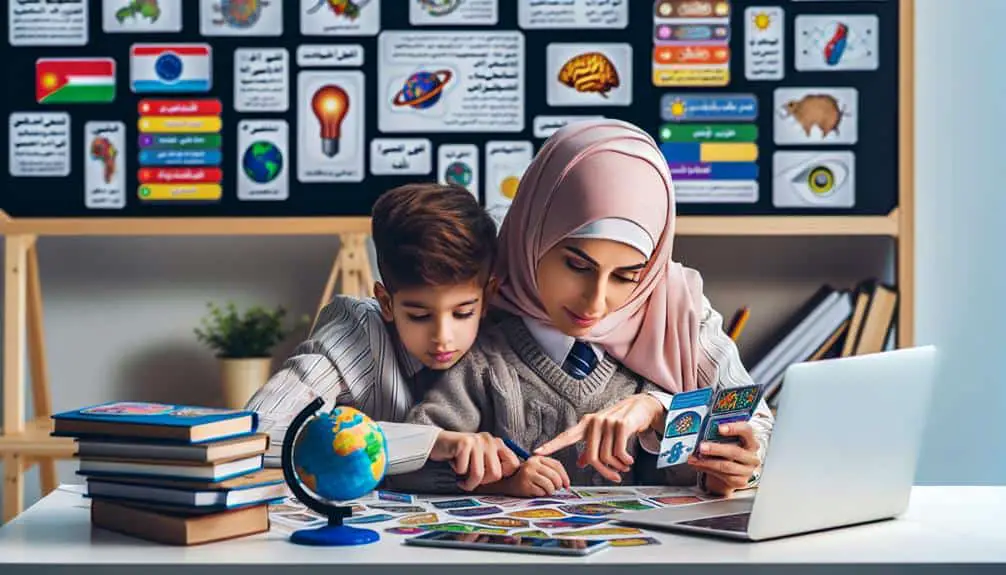Tailor your homeschooling to match your child's learning style preferences. Use visual aids for visual learners and hands-on activities for kinesthetic learners. Understand your child's style to succeed. Customize lessons with varied teaching methods. Adapt materials to fit their unique needs. Engage with colorful visuals and experiments. Create a personalized learning experience with interactive resources. Continuously assess and adjust your approach for success.Keep tailoring your methods to enhance academic achievement effectively.
Key Points
- Identify your child's learning style through observation and assessment.
- Tailor curriculum to incorporate suitable approaches for different types of learners.
- Use diagrams, charts, and visual aids for visual learners.
- Implement interactive online resources and educational games.
- Continuously evaluate and adjust lessons to match learning preferences.
Understanding Learning Style Preferences
To effectively tailor learning experiences for homeschool success, it's essential to understand your child's unique learning style preferences. Children often fall into different categories when it comes to learning styles, with two common types being visual learners and kinesthetic learners.
Visual learners tend to absorb information best through visual aids such as graphs, charts, and diagrams. For these children, incorporating colorful visuals into their lessons can enhance their understanding and retention of the material. Using educational videos or illustrations can also be beneficial.
On the other hand, kinesthetic learners learn best through hands-on activities and movement. These children thrive when given the opportunity to engage in experiments, role-playing, or physical tasks related to the lesson. Incorporating activities that involve building, creating, or moving around can help kinesthetic learners grasp concepts more effectively.
Identifying Your Childs Learning Style
Understanding your child's learning style is the key to tailoring learning experiences for homeschool success. Identifying whether your child is a visual learner, who thrives on images and spatial understanding, or benefits more from hands-on activities, which involve active participation and manipulation of objects, can have a significant impact on their educational journey. Visual learners grasp concepts better when information is presented visually, such as through charts, diagrams, or videos. On the other hand, hands-on activities allow children to engage with materials directly, enhancing their comprehension through physical interaction.
Observing your child's responses to different teaching methods can provide clues about their learning style. For visual learners, you may notice their preference for watching educational videos or their ability to remember information better when presented in a visual format. In contrast, hands-on learners might excel in activities that involve building, creating, or experimenting with objects. By recognizing and understanding your child's learning style, you can tailor your homeschooling approach to align with their strengths, fostering a more effective and enjoyable learning experience.
Tailoring Curriculum to Learning Styles
When tailoring curriculum to learning styles, consider incorporating a variety of teaching methods that cater to your child's individual strengths and preferences. Customized lessons and individualized progress are key components in creating a successful homeschool environment. Personalized teaching allows you to adjust materials to suit your child's unique way of learning, making the educational experience more engaging and effective.
To guarantee customized lessons, start by identifying your child's learning style through observation and assessment. Whether your child is a visual, auditory, kinesthetic, or a combination of these learners, tailor the curriculum to incorporate suitable approaches. For visual learners, use visual aids, diagrams, and color-coding in lessons. Auditory learners may benefit from discussions, lectures, and audiobooks. Kinesthetic learners thrive with hands-on activities, experiments, and practical applications.
Adaptable materials are essential for accommodating different learning styles. Invest in resources that offer flexibility and variety, allowing you to adjust the curriculum as needed. By tailoring the curriculum to your child's learning style, you create a personalized and effective homeschooling experience tailored to their unique needs.
Implementing Strategies for Success
Consider incorporating a range of effective teaching strategies tailored to your child's unique learning style for homeschool success. Customizing lessons to match how your child learns best can greatly enhance their understanding and retention of the material. Personalized approaches catered to their strengths and preferences can make learning more engaging and fruitful.
To implement strategies for success in homeschooling, first, identify your child's learning style through observation and experimentation. Once you have a clear understanding of how they learn best, you can start customizing lessons accordingly. For visual learners, incorporating diagrams, charts, and visual aids can be beneficial. Auditory learners may benefit from discussions, audiobooks, or reading aloud. Kinesthetic learners thrive with hands-on activities and experiments.
Additionally, consider incorporating a variety of teaching methods to keep your child engaged and motivated. Combining traditional lectures with interactive online resources, educational games, and field trips can provide a well-rounded learning experience. By tailoring your teaching strategies to your child's unique learning style, you can create a more effective and enjoyable homeschooling environment.
Evaluating and Adjusting Approaches
To optimize homeschooling success, continuously assess and adapt your teaching approaches based on your child's progress and feedback. Utilizing effective assessment techniques is vital in gauging your child's understanding and learning style. Consider using methods such as quizzes, observations, and discussions to evaluate comprehension and identify areas for improvement. Through regular assessments, you can tailor your teaching to address your child's specific needs and strengths.
Customized activities play an essential role in keeping your child engaged and motivated. By adjusting the content and format of lessons to match your child's interests and learning preferences, you can enhance their overall learning experience. Incorporating hands-on activities, educational games, and real-life examples can help reinforce concepts and make learning more enjoyable.
Remember that homeschooling is a dynamic process that requires flexibility and openness to change. Be receptive to feedback from your child and be willing to adjust your approaches accordingly. By continuously evaluating and adapting your teaching methods, you can create a personalized learning environment that promotes success and academic growth.




